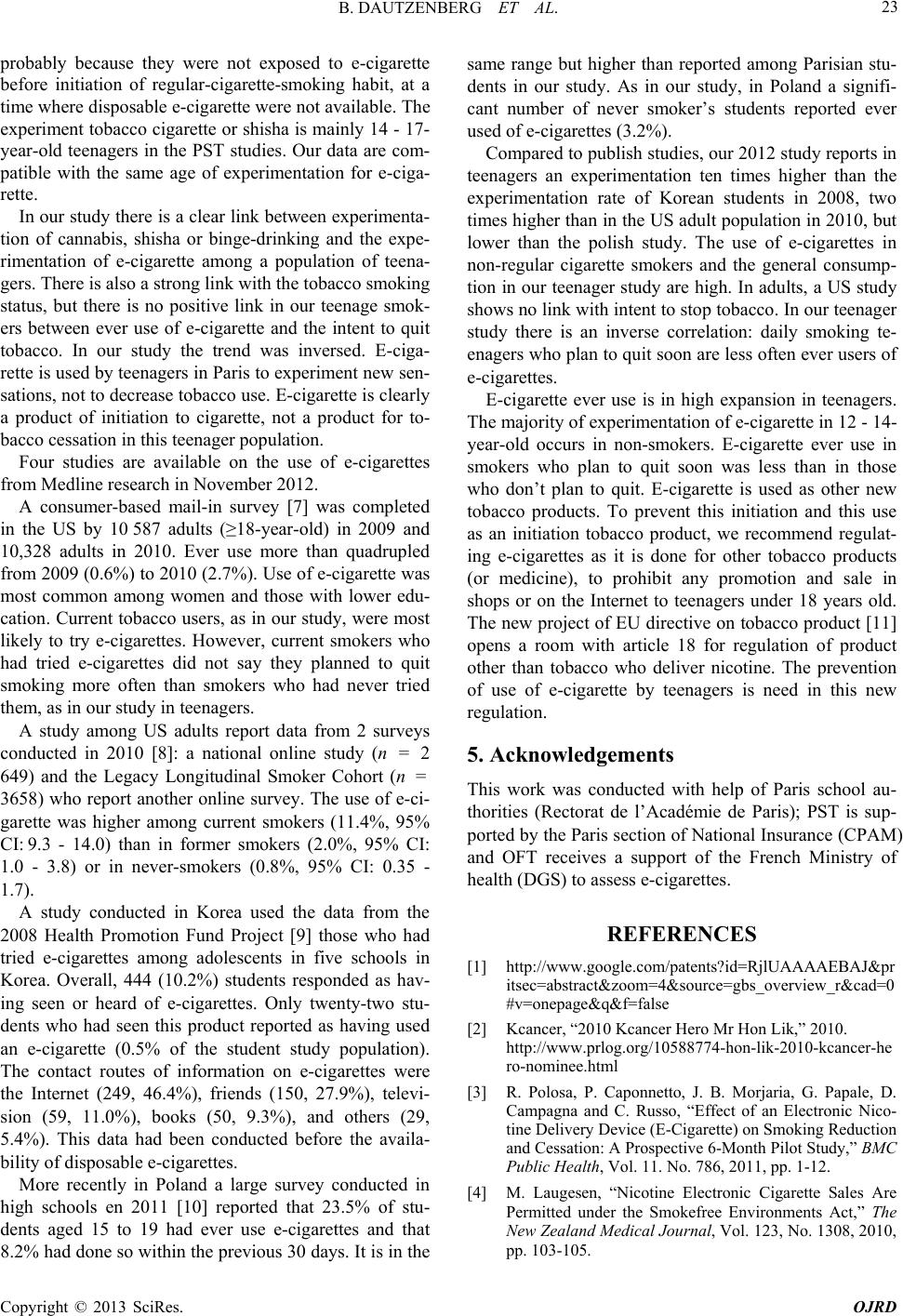
B. DAUTZENBERG ET AL. 23
probably because they were not exposed to e-cigarette
before initiation of regular-cigarette-smoking habit, at a
time where disposable e-cigarette were not available. The
experiment tobacco cigarette or shisha is mainly 14 - 17-
year-old teenagers in the PST studies. Our data are com-
patible with the same age of experimentation for e-ciga-
rette.
In our study there is a clear link between experimenta-
tion of cannabis, shisha or binge-drinking and the expe-
rimentation of e-cigarette among a population of teena-
gers. There is also a strong link with the tobacco smoking
status, but there is no positive link in our teenage smok-
ers between ever use of e-cigarette and the intent to quit
tobacco. In our study the trend was inversed. E-ciga-
rette is used by teenagers in Paris to experiment new sen-
sations, not to decrease tobacco use. E-cigarette is clearly
a product of initiation to cigarette, not a product for to-
bacco cessation in this teenager population.
Four studies are available on the use of e-cigarettes
from Medline research in November 2012.
A consumer-based mail-in survey [7] was completed
in the US by 10 587 adults (≥18-year-old) in 2009 and
10,328 adults in 2010. Ever use more than quadrupled
from 2009 (0.6%) to 2010 (2.7%). Use of e-cigarette was
most common among women and those with lower edu-
cation. Current tobacco users, as in our study, were most
likely to try e-cigarettes. However, current smokers who
had tried e-cigarettes did not say they planned to quit
smoking more often than smokers who had never tried
them, as in our study in teenagers.
A study among US adults report data from 2 surveys
conducted in 2010 [8]: a national online study (n = 2
649) and the Legacy Longitudinal Smoker Cohort (n =
3658) who report another online survey. The use of e-ci-
garette was higher among current smokers (11.4%, 95%
CI: 9.3 - 14.0) than in former smokers (2.0%, 95% CI:
1.0 - 3.8) or in never-smokers (0.8%, 95% CI: 0.35 -
1.7).
A study conducted in Korea used the data from the
2008 Health Promotion Fund Project [9] those who had
tried e-cigarettes among adolescents in five schools in
Korea. Overall, 444 (10.2%) students responded as hav-
ing seen or heard of e-cigarettes. Only twenty-two stu-
dents who had seen this product reported as having used
an e-cigarette (0.5% of the student study population).
The contact routes of information on e-cigarettes were
the Internet (249, 46.4%), friends (150, 27.9%), televi-
sion (59, 11.0%), books (50, 9.3%), and others (29,
5.4%). This data had been conducted before the availa-
bility of disposable e-cigarettes.
More recently in Poland a large survey conducted in
high schools en 2011 [10] reported that 23.5% of stu-
dents aged 15 to 19 had ever use e-cigarettes and that
8.2% had done so within the previous 30 days. It is in the
same range but higher than reported among Parisian stu-
dents in our study. As in our study, in Poland a signifi-
cant number of never smoker’s students reported ever
used of e-cigarettes (3.2%).
Compared to publish studies, our 2012 study reports in
teenagers an experimentation ten times higher than the
experimentation rate of Korean students in 2008, two
times higher than in the US adult population in 2010, but
lower than the polish study. The use of e-cigarettes in
non-regular cigarette smokers and the general consump-
tion in our teenager study are high. In adults, a US study
shows no link with intent to stop tobacco. In our teenager
study there is an inverse correlation: daily smoking te-
enagers who plan to quit soon are less often ever users of
e-cigarettes.
E-cigarette ever use is in high expansion in teenagers.
The majority of experimentation of e-cigarette in 12 - 14-
year-old occurs in non-smokers. E-cigarette ever use in
smokers who plan to quit soon was less than in those
who don’t plan to quit. E-cigarette is used as other new
tobacco products. To prevent this initiation and this use
as an initiation tobacco product, we recommend regulat-
ing e-cigarettes as it is done for other tobacco products
(or medicine), to prohibit any promotion and sale in
shops or on the Internet to teenagers under 18 years old.
The new project of EU directive on tobacco product [11]
opens a room with article 18 for regulation of product
other than tobacco who deliver nicotine. The prevention
of use of e-cigarette by teenagers is need in this new
regulation.
5. Acknowledgements
This work was conducted with help of Paris school au-
thorities (Rectorat de l’Académie de Paris); PST is sup-
ported by the Paris section of National Insurance (CPAM)
and OFT receives a support of the French Ministry of
health (DGS) to assess e-cigarettes.
REFERENCES
[1] http://www.google.com/patents?id=RjlUAAAAEBAJ&pr
itsec=abstract&zoom=4&source=gbs_overview_r&cad=0
#v=onepage&q&f=false
[2] Kcancer, “2010 Kcancer Hero Mr Hon Lik,” 2010.
http://www.prlog.org/10588774-hon-lik-2010-kcancer-he
ro-nominee.html
[3] R. Polosa, P. Caponnetto, J. B. Morjaria, G. Papale, D.
Campagna and C. Russo, “Effect of an Electronic Nico-
tine Delivery Device (E-Cigarette) on Smoking Reduction
and Cessation: A Prospective 6-Month Pilot Study,” BMC
Public Health, Vol. 11. No. 786, 2011, pp. 1-12.
[4] M. Laugesen, “Nicotine Electronic Cigarette Sales Are
Permitted under the Smokefree Environments Act,” The
New Zealand Medical Journal, Vol. 123, No. 1308, 2010,
pp. 103-105.
Copyright © 2013 SciRes. OJRD